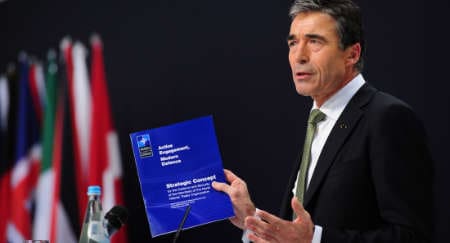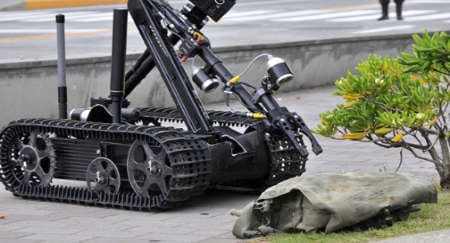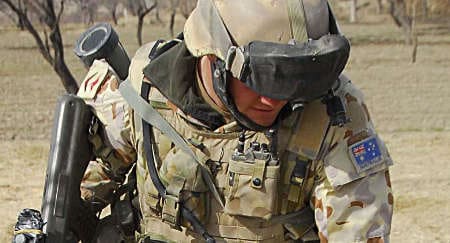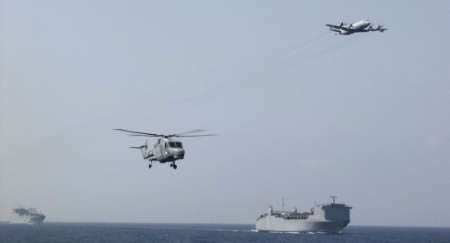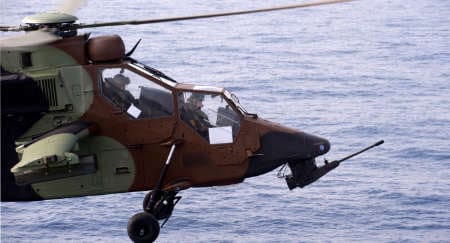For a truly modern approach to bringing NATO up to speed on 21st century security threats, the Alliance needs smart spending, more commitment and clearer planning, argues Dr Jacquelyn Davis.
In the post-9/11 decade, NATO nations must redress declining defence spending trends and decide once and for all if the transatlantic defence relationship is worth maintaining. The precedent demonstrated most recently by Operation Unified Protector is not encouraging.
The US policy of “leading from behind” in Libya while providing essential capabilities will never prevail if the European NATO allies remain unprepared to raise defence budgets. Allies must also work collectively to address fundamental questions facing the Alliance about the use of force against new and emerging threats to Alliance security.
And NATO’s need for more systematic planning on irregular and asymmetric threats from non-state actors may not have been emphasised enough in its new Strategic Concept. This deserves new thinking in Article 5 (an attack on one is an attack on all) planning as well.
Look at lone-wolf terrorists, space and cyber threats, energy security, weapons of mass destruction and their pursual by terrorist organisations
Even as the NATO’s last Summit in Lisbon reaffirmed NATO’s Article 5 defence as a core mission, debate continues about what this means in a 21st century landscape. Security challenges now range from state actors and non-state armed groups employing high technology weapons in asymmetrical ways to low-technology weapons which induce terror and produce heavy civilian casualties. Most of these depart significantly from Alliance (and Western) concepts of war, which have evolved to focus on minimising casualties, avoiding civilian losses, and terminating operations as soon as feasible.
And it’s not just these threats. Look at lone-wolf terrorists, space and cyber threats, energy security, weapons of mass destruction and their pursual by terrorist organisations. These all raise questions about the meaning of Article 5 in today’s world, and how it should be implemented.
However, I believe that NATO's discussion of Article 5 especially in the run-up to the new Strategic Concept end 2010, was characterised by a false debate over territorial defence and expeditionary capabilities. As many Allies point out, the defense of NATO territory (especially along the flanks) requires expeditionary forces. Therefore, the transformation of NATO to embrace greater mobility, precision, and interoperability can only enhance—not detract from—NATO’s territorial defence missions.
The basic question for Alliance planners is if NATO planning, as it moves forward, is adequately taking into account the possibility that non-state actors might be empowered by state actors to attack NATO.
This raises a dilemma because some member nations remain more interested in territorial defence planning along more traditional lines, especially Russian-related contingencies. Other Allies are more willing to entertain new, sometimes unconventional, ideas about force posture, based on a diversity of “threat” perceptions and national interests.
Moreover, while territorial defence remains central to security planning, today’s emerging security challenges are increasingly at odds with that notion because borders are more porous and irrelevant to ballistic missiles or to cyber threats. Just how to defend against these types of threats in an era of constrained resources (and lower defence spending) is the central question for the Alliance at a time in which there is not always consensus on future threats (Iran), needed capabilities (missile defense), and on the use of force itself (national caveats).
Thus, while contingency planning for any one of a number of contingencies involving Russia remains an important aspect of Allied Command Operations (ACO) planning, it is not the principal Article 5 challenge that NATO must address. Iran’s potential emergence as a nuclear weapons state, with a ballistic missile capacity to target Europe, must also be singled out, in keeping with the core Article 5 missions of defence and deterrence.
However, in today’s world, territorial defense must embrace critical infrastructure protection, consequence management, planning to thwart an Electro-Magnetic Pulse (EMP) attack, aspects of energy security and cyber operations.
Obviously, not all cyber attacks can or should be regarded as an Article 5 emergency. The question, then, emerges about when and how a cyber attack, or an attack on energy infrastructure might be related to a state-sponsored contingency, in which defence of NATO assets emerges as a full-blown Article 5-type challenge.
What is worrying in this regard is the potential nexus between state-sponsored attacks against NATO and non-state armed groups that might be tasked to carry out such an attack. This could be either to confuse about the origins of an attack, or to complicate NATO deliberations about responding to such an attack. Iran’s reliance on Hezbollah is a case in point, although there is no NATO consensus yet on the threat or challenge that Iran may pose to Alliance interests.
In the cyber arena, there is also the possibility of non-state actor attacks, sponsored by a nation-state, as seems to be the case with recent probes into US and NATO security networks.
The question for the Alliance will be to what extent these types of attacks risk harming security interests. Even assuming that attributing their origin can be done, how should they be dealt with in an era when NATO nations cannot always agree on the use of force, much less on preventive action?
During deliberations on the NATO’s new Strategic Concept, the issue of a terrorist detonation of an improvised nuclear device (IND) in a European city was raised. Preventive action would be an important aspect of contingency planning for this kind of scenario. But it was difficult to get agreement on implementation of any type of preventive action, much less on the use of force to go after the perpetrators, if attribution was established. The problem is that preventive action depends on “exquisite” intelligence, and NATO relies on its member-states for all-source intelligence capabilities.
As the new Strategic Concept suggests, a “comprehensive approach” in which non-military capabilities, non-governmental and international organisations and international partnerships with non-NATO nations might be needed to execute future NATO missions. This implies a new way of operating in the Alliance. For some Allies, such as France, it also means breaking the orthodoxy that NATO should not be involved with civil agencies and in non-military functions (police training, for example).
NATO does already have a civil emergency planning capability, and one of the areas for future growth is likely to be NATO’s Senior Civil Emergency Planning Committee (SCEPC). There may, for example, be the emergence of new mission taskings in the areas of forensics, biometrics, and in consequence management of a WMD event.
An additional critical aspect of preventive planning is the need to have access to high quality intelligence about potential adversaries, their capabilities, and their relationships on the ground with other groups, governments, and interested parties. The need to refine and maximise the role of special operations forces (SOF) in NATO planning is a critical requirement.
This is especially so if NATO is seeking to operate in areas in which its understanding of trends, capabilities, and relationships is less than substantial. NATO has already begun to do this by creating an all-source intelligence network with the capacity to support operations in theatre as well as to provide crucial planning information for crisis contingencies.
Global and non-traditional partner relationships are also essential to Alliance efforts to realise a comprehensive strategy. This could be where NATO forces support a non-military lead-agency or an international partner such as the United Nations, in a crisis contingency. Already, ISAF in Afghanistan is operating with a broader community of coalition partners, including, for example, Australia and New Zealand. This is a phenomenon that is only likely to increase in the years ahead, with globalisation and the nature of comprehensive planning. Indeed, as NATO’s 2010 Strategic Concept made clear, NATO is a regional Alliance with global reach.
Today in Libya too, NATO forces are operating with non-NATO partners, notably from Qatar and the United Arab Emirates (UAE). Both of these Arab states played significant roles in training the Libyan opposition forces, validating the “train the trainer” concept that is central to NATO special forces’ planning. As we go forward, this construct - together with the need for enhancing interoperability with non-NATO partners - will become more urgent. Especially if NATO chooses to operate in other theatres where success or failure depends on proxy operations and/or partner collaboration.
At present, NATO has implemented only one anti-terror operation (Active Endeavour or OAE), which is focused on maritime interdiction in the Mediterranean Sea. Limited to focus on terrorist or WMD intercepts, Active Endeavour was never meant to be a template for future NATO anti-terrorism planning. Some NATO strategists have suggested the need to broaden OAE into a larger, maritime security tasking, harking back to the days when sea lines of communication security was identified as a mainstay of Alliance planning.
In this respect, on the basis of the new Alliance Maritime Strategy from March 2011, there is new thinking in Alliance planning circles about a more comprehensive maritime security approach for NATO. This could see an explicit division of labor with the European Union (EU) over roles and missions, provided that the EU can really develop the credible security and defence identity its members have professed to be their objective.
However, the perceived failure of the EU to act with respect to Libya, and the fact that only a handful of European NATO nations participated at sharp end of Operation Unified Protector, diminishes the probability of this happening in an era of declining defence resources. Therefore, NATO appears to be the most credible framework for collective action and to address European security concerns as we move into the future. This, or course, assumes that the United States and its European partners remain engaged and willing to expend the resources necessary to meet emerging needs.
As NATO considers a new capabilities initiative to be unveiled at the 2012 Chicago Summit, Alliance leaders should be considering new ways to get access to essential enablers, which are often owned and protected by individual nations and their service leaderships.
One idea is to identify assets that might be tapped for operations and then to get interested nations to pool these resources for Alliance purposes. This is the essence of what Secretary General Rasmussen has termed a “smart defence” approach—that is, defence savings realised from new collaborative approaches. This requires a broader understanding that, notwithstanding individual national requirements, Alliance members are partners striving to achieve common objectives.
For many NATO nations, this promises to be a difficult exercise. It will require even further fundamental changes in how their militaries do business. However, out of necessity, and due to the financial crisis, defence planners may have no option but to revisit old constructs, such as forces’ rationalisation and pooling, and devise new ideas for operational planning, if they wish to maintain force structure and needed capabilities.
Indeed, Britain and France are exploring options to do just that, while other allies, the Dutch and the Belgians, for example, have been collaborating for years. By doing so, they maintain crucial capabilities in areas where neither nation wanted to lose operational capability. So identifying crucial capabilities for future Alliance planning is a key task if NATO nations are serious about maintaining NATO’s relevance.
As shown by NATO operations in Afghanistan and over Libya, stabilisation and counter-insurgency planning are based on different skill-sets and rules of engagement (for the use of force) than those essential to protect NATO populations and territories. NATO forces have had a steep learning-curve in this regard, which Afghanistan has served to promote.
But the question for future NATO planners is whether the Alliance will again be engaged in such ambitious operations outside NATO borders anytime soon. As the Alliance deliberations over Libya demonstrated, there is little political appetite for doing so, much less the capabilities to support the post-conflict phase of stabilisation operations, which might very well entail nation-building competencies.
However, other challenges looming on the horizon may require NATO involvement, even if not all of the NATO Allies are willing to participate. Clearly, demonstrating an ability to do so may well be important if the Alliance is to remain relevant to new era challenges and threats. This will be especially so to a sceptical US Congress and others who remain frustrated by cumbersome Alliance processes that sometimes stand in the way of NATO’s ability to maximise the benefits of collective action and cooperation.


